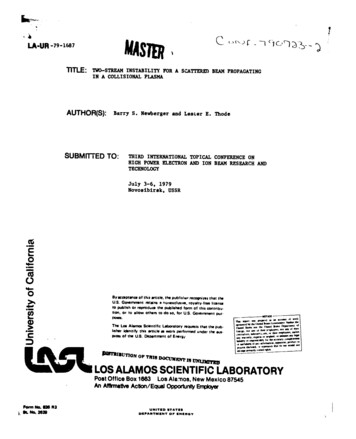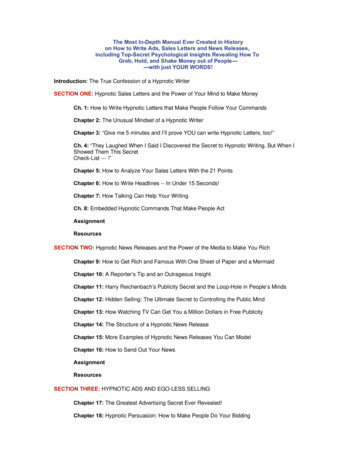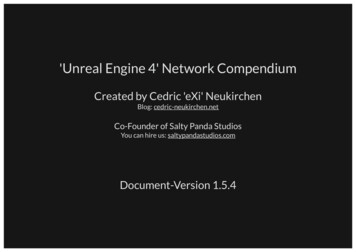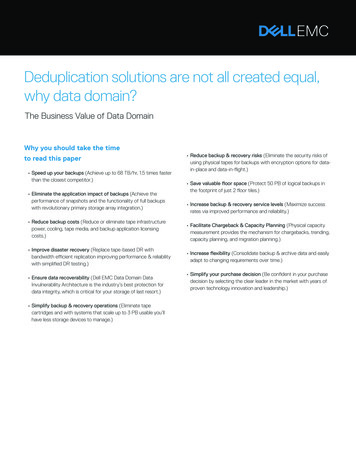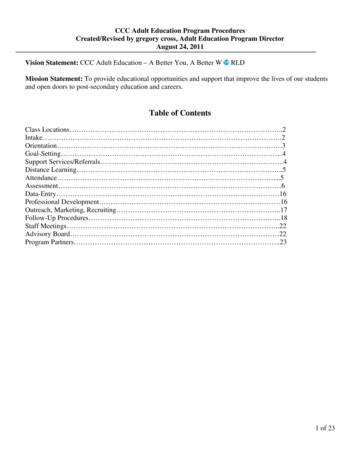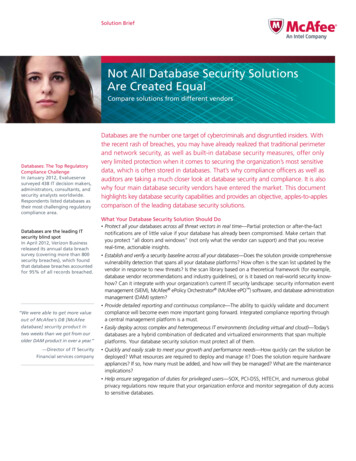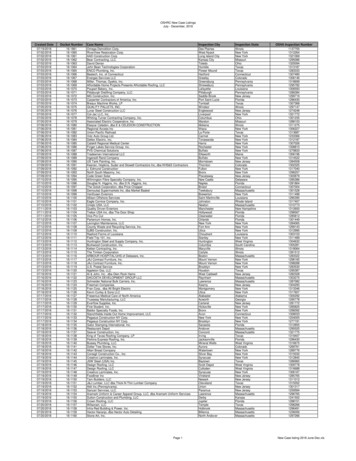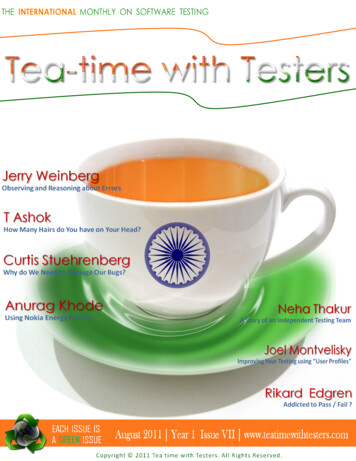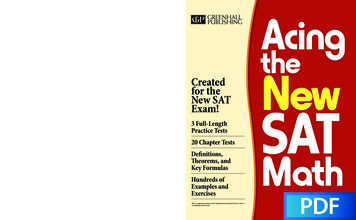
Transcription
This book covers all of the mathconcepts you need to know for theNew SAT, organized in twenty chaptersby subject, so you can focus on areasyou find especially challenging.Important vocabularies, definitions,and formulas are in the beginning ofeach section to teach you as directlyand clearly as possible. Accompanyingexamples and solutions show you howto apply your knowledge.These realistic practice tests give youpractical preparation, helping you getcomfortable with the New SAT exam.Complete answers and explanationshelp you identify weaknesses and attainmaximum benefits out of the practice test.CREATED FOR THENEW SAT EXAM!A set of exercises in each section, andchapter test at the end of each chapter, comewith detailed step-by-step solutions.Acing the New SAT MathUnderstand the BasicConcepts of Algebra I, II,Geometry, Statistics,and Trigonometry. LearnProblem SolvingTechniques.AcingCreatedfor theNew SATExam!3 Full-LengthPractice Tests20 Chapter TestsDefinitions,Theorems, andKey FormulasHundreds ofExamples andExercises 14.00ISBN 978-0-9754753-6-2* SAT is a registered trademark of the College Entrance Examination Board, which isnot affiliated with this booktheNewSATMathPDF
Acing theNew SAT Mathby Thomas HyunGREENHALL PUBLISHINGTHOUSAND OAKS, CA
Copyright 2016 by Greenhall PublishingAll rights reserved. No part of this book may be used or reproduced in anymanner without the written permission of the publisher.This edition published by Greenhall PublishingGreenhall PublishingThousand Oaks, CA 91358http:// greenhallpublishing.comWritten by Thomas HyunCover design by Hespenheide DesignPrinted in the United States of AmericaISBN-10: 0-9754753-6-3ISBN-13: 978-0-9754753-6-2SAT is a registered trademark of the College Entrance Examination Board,which is not affiliated with this book.
CONTENTSTo the StudentsviPart A – Math ReviewI. Heart of AlgebraChapter 1: The Language and Tools of Algebra1-11-21-31-4Variables and ExpressionsExponents and Order of OperationsSimplifying Algebraic ExpressionsRational, Irrational, and DecimalChapter 1 Practice TestAnswers and ExplanationsChapter 2: Solving Linear Equations2-12-22-32-42-5Writing EquationsSolving EquationsSolving Equations with Variables on Both SidesEquations with No Solution and IdentitySolving for a Specific VariableChapter 2 Practice TestAnswers and ExplanationsChapter 3: Functionsand Linear Equations3-13-23-33-43-53-6Relations and FunctionsRate of Change and SlopeSlope-Intercept Form and Point-Slope FormParallel and Perpendicular LinesSolving Systems of Linear EquationsAbsolute Value EquationsChapter 3 Practice TestAnswers and ExplanationsChapter 4: Linear Inequalities and Graphs4-14-24-34-4Solving InequalitiesCompound and Absolute Value InequalitiesGraphing Inequalities in Two VariablesGraphing Systems of InequalitiesChapter 4 Practice TestAnswers and 50525461616365676971
ii ContentsChapter 5: Word Problems in Real-Life Situation5-15-25-35-4Solving Word Problems Using Linear ModelsSolving Word Problems with EquationsSolving Word Problems Using Systems of EquationsSolving Word Problems Using InequalitiesChapter 5 Practice TestAnswers and Explanations77777981838587II. Statistics and Data AnalysisChapter 6: Ratios, Rates, and Proportions6-1 Ratios and Rates6-2 Proportions6-3 Ratios, Rates, and Proportions Word ProblemsChapter 6 Practice TestAnswers and ExplanationsChapter 7: Percents959597991011031097-1 Percent of Change7-2 Percents and Equations7-3 Percent Word Problems109111113Chapter 7 Practice TestAnswers and Explanations115117Chapter 8: Statistics8-18-28-38-48-5Mean, Median, Mode, and RangeStandard DeviationGraphical DisplaysScatter PlotsPopulations, Samples, and Random SelectionChapter 8 Practice TestAnswers and ExplanationsChapter 9: Categorical Data and Probability9-1 Permutations and Combinations9-2 Rules of Probability9-3 Categorical Data and Conditional ProbabilitiesChapter 9 Practice TestAnswers and 5147
Contents iiiIII. Advanced MathChapter 10: Law of Exponents and Polynomials10-110-210-310-410-5Laws of Exponents and Scientific NotationAdding, Subtracting, Multiplying, and Dividing PolynomialsFOIL Method and Special ProductsPrime Factorization, GCF, and LCMFactoring Using the Distributive PropertyChapter 10 Practice TestAnswers and ExplanationsChapter 11: Quadratic Functions11-111-211-311-411-511-6Graphs of Quadratic EquationsFactoring TrinomialsFactoring Differences of Squares and Perfect Square TrinomialsSolving Quadratic Equations by Completing the SquareQuadratic Formula and the DiscriminantSolving Systems Consisting Linear and Quadratic EquationsChapter 11 Practice TestAnswers and ExplanationsChapter 12: Composition, Recursion, and Exponential Functions12-112-212-312-4Composition of FunctionsRecursive FormulaExponential Functions and GraphsExponential Growth and DecayChapter 12 Practice TestAnswers and ExplanationsChapter 13: Polynomial and Radical Functions13-113-213-313-413-5Polynomial Functions and Their GraphsRemainder Theorem and Factor TheoremRadical ExpressionsSolving Radical EquationsComplex NumbersChapter 13 Practice TestAnswers and 22225227
iv ContentsChapter 14: Rational Expressions14-114-214-314-4Rational ExpressionsSolving Rational EquationsDirect, Inverse, and Joint VariationSolving Word Problems Using Rational EquationsChapter 14 Practice TestAnswers and ExplanationsChapter 15: Trigonometric Functions15-1 Trigonometric Ratios of Acute Angles15-2 The Radian Measure of an Angle15-3 Trigonometric Functions of General Angles and the Unit CircleChapter 15 Practice TestAnswers and 1IV. GeometryChapter 16: Lines and Angles16-1 Lines, Segments, and Rays16-2 Angles16-3 Parallel and Perpendicular LinesChapter 16 Practice TestAnswers and Explanations to Exercises and Practice TestChapter 17: Triangles17-117-217-317-4Angles of a TrianglesPythagorean Theorem and Special Right TrianglesSimilar Triangles and Proportional PartsArea of a TriangleChapter 17 Practice TestAnswers and ExplanationsChapter 18: Polygons18-1 Parallelograms18-2 Rectangles, Squares, and Trapezoids18-3 Regular PolygonsChapter 18 Practice TestAnswers and 9295295297299301303
Contents vChapter 19: Circles19-119-219-319-419-5Arcs, Angles, and TangentsArc Lengths and Areas of SectorsInscribed AnglesArcs and ChordsEquations of CirclesChapter 19 Practice TestAnswers and ExplanationsChapter 20: Surface Areas and Volumes20-1 Prisms20-2 Cylinders and Spheres20-3 Pyramids and ConesChapter 20 Practice TestAnswers and 3335Part B – Practice TestsPSAT 10 Practice Test341Answers and Explanations360SAT Practice Test 1367Answers and Explanations388SAT Practice Test 2399Answers and Explanations421
vi To the StudentsTo the Students If you’re reading this, you are on your way to a better score on the New SAT math! Below areguidelines for getting the most out of this book, as well as information about changes to the mathsection of the New SAT.Using this Book This book helps students review and master mathematical concepts in the most concise andstraightforward manner possible. Each of the twenty chapters in this book teaches a particular group of mathematical conceptsyou need to know for the New SAT.Each chapter contains lessons that convey key concepts along with illustrations and diagrams.Important vocabularies are printed in boldface. Next to the key terms and illustrations, you will find examples, with complete solutions, thatapply the application of the concepts you have just learned. Keep a pencil and sheet of paperhandy. Follow along, working out the sample questions yourself – this will help you later insolving the practice problems. This book is not only helpful for SAT Math, but is also a very useful supplement for high schoolmath courses.Exercise Sets and Practice Tests Each lesson includes a set of practice problems for the lesson. Each chapter includes a practicetest followed by answers and explanations, to ensure that you master the material.PSAT and SAT Practice Tests At the end of the book, you will find one PSAT and two SAT practice tests. For maximum benefit,these should be taken under realistic testing-center conditions – timed and free from outside distractions.About the New SAT MathContent Starting in spring of 2016, the math portion of the SAT will cover Algebra I and II, Geometry,parts of Trigonometry, and parts of Statistics. For the new exam students must also be familiar withmaterials typically taught in Algebra II, Trigonometry, and Statistics. The math portion of the SAT will consist of two sections – one 25-minute no-calculator sectionand one 55-minute calculator section., for a total of 80 minutes in math testing.The new PSAT/NMSQT will also include the new topics, although the SAT will test for theseconcepts at a higher level. The math portion of the PSAT/NMSQT will consist of two sections –one 25-minute no-calculator section and one 45-minute calculator section, for a total of 70 minutesin math testing. Math questions on the SAT and PSAT fall into two main categories: multiple choice (with fouranswer choices given) and student produced response questions. Student produced responsequestions, commonly referred to as “grid-ins,” require students to formulate their own answers, thenenter the numeric values into a special grid. Multiple choice questions have no penalty for guessing!
vii To the StudentsSATNo-Calculator SectionNumber ofQuestionsMultiple Choice (MC)15Student-Produced Response (SPR - Grid-In)5Sub Total20Number ofQuestionsCalculator SectionMultiple Choice (MC)PSATTimeAllocatedSub Total825 minutes58425 minutes17TimeAllocatedNumber ofQuestionsTimeAllocated2755 minutes38TotalTimeAllocated1330Student-Produced Response (SPR - Grid-In)Number ofQuestions445 minutes3180 minutes4870 minutesStudy Timetable As with any test, students will see the best results by studying consistently over at least severalweeks before the exam date, rather than trying to cram and learn “test tricks” in a day or two.Students studying an hour a day over two months should be more than able to finish all theexercises in this book. The clear subject organization by chapter means you can focus yourefforts and spend more time on topics you are struggling with. While chapters can be broken upover a couple sessions, students should finish each practice test in one uninterrupted sitting.Calculators Students may use a four-function, scientific, or graphing calculator during the SAT exam(calculators with QWERTY keyboard are not allowed). Use of a calculator is highlyrecommended, though most of the problems can be solved without one. Becoming comfortablewith your calculator during test preparation will help you use this tool to solve problems morequickly and efficiently during the actual exam.Scoring Scores on the math portion of the SAT range from 200 to 800. An average score on the mathsection is about 500, but this can vary with each individual test. Consult the College Board Website (www.collegeboard.com) for further specifics.Signing Up for the SAT Students can register online for the SAT at the College Board Web site. Students can also pickup registration packets at their high schools and sign up via snail mail. Generally the registrationdeadlines are a little over a month before the actual testing date. Late registrations incuradditional fees.This book was written to be a straightforward study guide for the New SAT Math. There areno shortcuts or gimmicks, but taking the time to work through this book should leave you feelingconfident and well prepared for the test.Good luck!
PART A Math ReviewI. Heart of AlgebraII. Statistics and Data AnalysisIII. Advanced MathIV. Geometry
I. Arithmetic and AlgebraChapter 1: The language and Tools of AlgebraChapter 2: Solving Linear EquationsChapter 3: Functions and Linear EquationsChapter 4: Linear Inequalities and GraphsChapter 5: Word Problems in Real-Life Situation
CHAPTER 1The Language and Tools of Algebra1-1. Variables and ExpressionsIn algebra, variables are symbols used to represent unspecified numbers or values.An algebraic expression is a collection of numbers, variables, operations, and grouping symbols.Verbal PhraseAlgebraic ExpressionsAdditionThe sum of twenty and a number nNine more than twice a number aA number m increased by 1220 n2a 9m 12SubtractionThe difference between a number x and 7Three less than a number bThree times a number k decreased by fiveNine minus a number nx 7b 33k 59 nMultiplicationEleven times z to the third powerThe product of 2 and a number n11z 3 2n2x3Two thirds of a number xDivisionn divided by 8n/815dThe quotient of fifteen and a number dExample 1 Write an algebraic expression for each verbal expression.a. Ten less than one-fourth the cube of p .b. Twice the difference between x and sixteen.c. Four times the sum of a number and three.d. Four times a number increased by three.Solution1 3p 104b. 2( x 16)c. 4(n 3) a.d. 4n 3Example 2 Mr. and Mrs. Sawyer are taking their three children to an amusement park.The admission is a dollars per adult, c dollars per child and the cost ofeach ride is r dollars per person.a. Write an expression for the cost of admission plus 10 rides for the family.b. Find the cost of admission plus 10 rides if the admission per adult is 20 dollars,the admission per child is 12 dollars, and the cost of each ride is 8 dollars.Solution a. 2a 3c 10rb. 2 20 3 12 10 8 156Substitute 20 for a , 12 for c , and 8 for r .
6Chapter 1Exercise - Variables and Expressions41Twice the product of m and n decreased by thesquare of the sum of m and n .Which of the following is
11-5 Quadratic Formula and the Discriminant 183 11-6 Solving Systems Consisting Linear and Quadratic Equations 186 Chapter 11 Practice Test 188 Answers and Explanations 190 . Chapter 12: Composition, Recursion, and Exponential Functions 197 12-1 Composition of Functions 197 12-2 Recursive Formula 199 12-3 Exponential Functions and Graphs 201 12-4 Exponential Growth and Decay 203 Chapter 12 .

